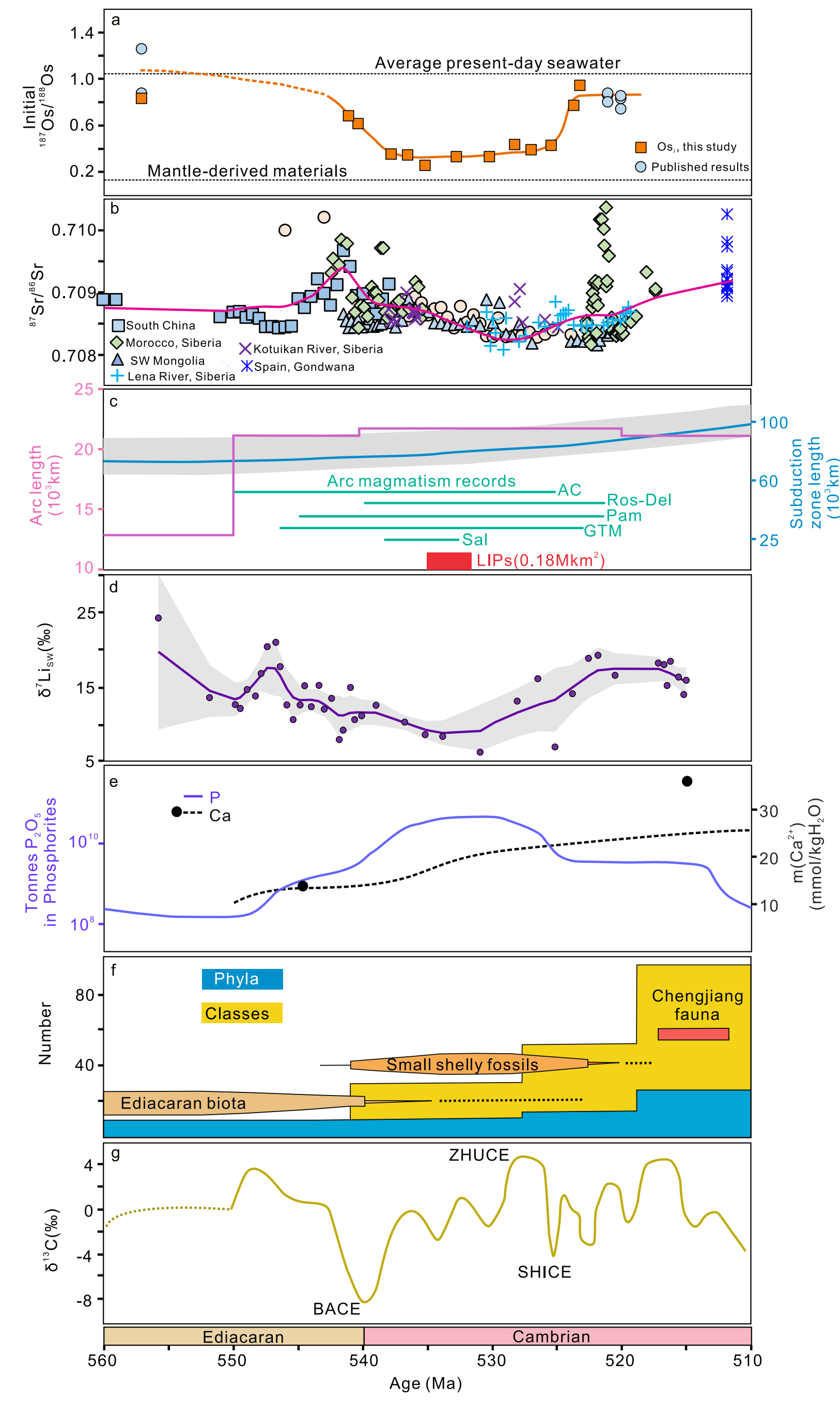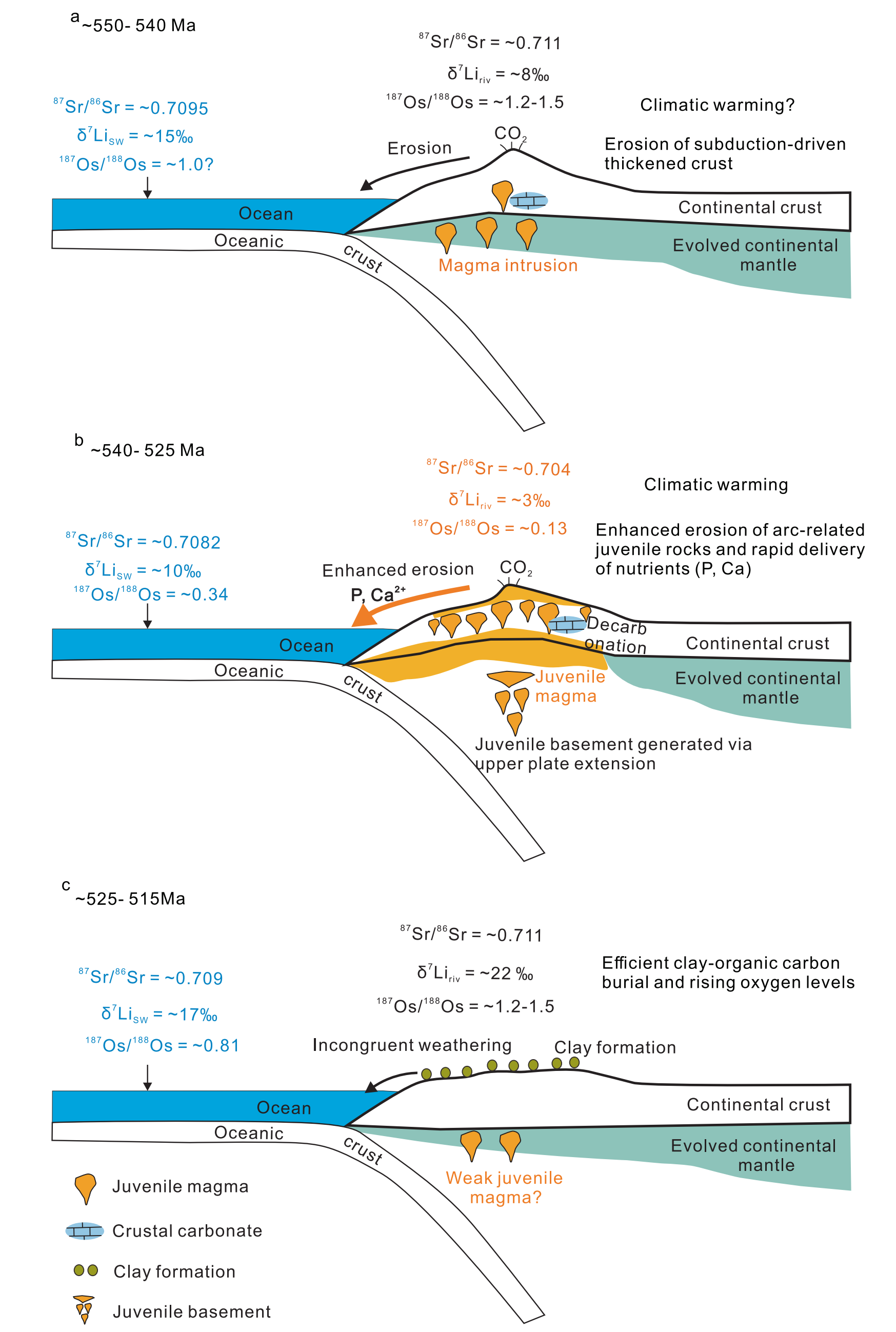大约5.4亿至5.15亿年前的寒武纪初期,地球生命发生了前所未有的快速演化,被称为“寒武纪生命大爆发”。为何复杂的多门类动物会在这一时期“突然”出现?学界普遍认为,营养元素(如磷)的供应和大气氧气水平的上升是两个关键的环境条件。然而,什么样的全球性构造事件触发了这些环境剧变一直是一个悬而未决的科学问题。虽然前人提出冈瓦纳大陆聚合造山作用驱动的风化营养盐输入和海水化学变化是寒武纪生命大爆发的重要机制,但主要的陆陆碰撞造山期(600Ma之前)要远早于寒武纪生命大爆发的时间。值得注意的是,冈瓦纳大陆边缘活跃的俯冲作用和大陆弧火山会促使高效的深部二氧化碳脱气和地幔物质抬升暴露,进而产生更强的风化-营养盐-海洋化学之间的反馈机制。鉴于该过程与寒武纪大爆发时间重叠,其极有可能是寒武纪生命大爆发的重要驱动力,但目前仍缺乏关键的地球化学证据来建立二者之间的因果联系。
鉴于此,在广州地化所彭平安院士指导下,由广州地化所田辉研究员和地化所樊海峰研究员共同主导,合肥工业大学、德国迈因茨大学、美国迈阿密大学、荷兰乌得勒支大学等国内外多家研究机构参与的联合研究团队,提出了地球深浅联动驱动的寒武纪生命大爆发新模式。
研究团队选取了华南扬子区块两个钻井(ZK4803和ZK4411)中保存完好的碳酸盐岩和黑色页岩/硅质岩样品,综合新获取的锂(Li)和锇(Os)同位素和已发表的锶(Sr)同位素数据,发现在5.4亿至5.25亿年前海水的上述地球化学指标出现了同步的显著 “负漂移” ,即Os和Sr同位素比值变轻,同时Li同位素(δ⁷Li)值急剧降低(图1)。Os-Sr同位素的负漂移指示了大量来自地幔的年轻非放射成因物质被风化并输入海洋。Li同位素的负漂移则指示当时正处于强烈的一致性风化阶段,岩石被快速溶解,侵蚀率极高。据此,研究团队推断在这一时期发生了大陆弧火山驱动的气候变暖和新鲜火山岩石的快速侵蚀作用。
基于上述新发现并综合前人成果,研究团队创新性提出了“构造-风化-生命”三阶段演化模型,清晰地勾勒出了该时期从构造活动到生命爆发的关联演化过程(图2):
(1)早期地壳增厚阶段(约550–540 Ma):俯冲作用导致大陆地壳增厚和气候变暖,启动了强烈的风化作用。
(2)关键营养(磷)输入和增氧阶段(约540–525 Ma):大陆弧火山活动进入高峰,富含磷等营养元素的新鲜火山岩被快速侵蚀,向海洋输送了前所未有的磷,极大促进了海洋生产力,随之而来的有机碳埋藏则导致大气氧含量上升。
(3)氧气巩固与生命辐射阶段(约525–515 Ma):风化模式转变为以形成粘土为主的不一致风化。粘土矿物促进有机质高效埋藏,进一步增进了大气氧积累,最终满足了大型、具骨骼动物演化的氧气需求,直接催生了寒武纪生命大爆发。
这项研究不仅解答了“什么构造过程驱动了寒武纪环境变革”这一长期悬而未决的问题,也进一步证明了地球深部活动(俯冲与弧火山作用)、地表风化过程、海水地球化学与生命演化的紧密联系,为学界深入理解地球系统各圈层如何协同打造地球宜居性这一地球科学前沿研究提供了新的案例。目前,该研究已在线发表在国际知名期刊Nature Communications,论文第一作者为广州地化所伍耀文博士,广州地化所田辉研究员和地化所樊海峰研究员为论文通讯作者,广州地化所李杰正高级工程师指导了Re-Os同位素测试。该研究受国家自然科学基金和重点研发计划联合资助。
论文信息:
Yaowen Wu, Hui Tian*, Haifeng Fan*, Philip A. E. Pogge von Strandmann, Wei Zhao, Jie Li, He Sun, Haiou Gu, Chaojin Lu, Xianyi Liu, Tengfei Li, Sui Ji & Ping’an Peng, 2025. Enhanced erosion by continental arc volcanism as a driver of the Cambrian Explosion. Nature Communications 16, 9204. DOI: 10.1038/s41467-025-64253-w.

图1 约560–510 Ma期间的构造运动、磷块岩分布、同位素地球化学记录(δ13Ccarb-Os-Sr-Li)与生物多样性模式关系图。a:本研究及前人报道的Os同位素记录(Xu et al., 2011; Fu et al., 2016);b:汇总的Sr同位素记录(Derry et al., 1994; Brasier et al., 1996; Kaufman et al., 1996; Kaufman et al., 2007);c:大陆弧长度、俯冲带长度(Mills et al, 2017)、LIPs (Ernst et al., 2021) 以及弧岩浆活动记录(Zhu et al., 2012; Brown et al., 2020; Oriolo et al., 2021);d:钻孔ZK4803碳酸盐岩样品的Li同位素记录。紫色线显示使用局部加权散点平滑法得到的最佳估计曲线,其95%置信区间以灰色区域表示;e: 全球尺度磷块岩矿床估算的P2O5吨位(Cook and Shergold,1984) 以及海水Ca2+浓度演化(Horita e al., 2002; Brennan et al., 2004);f :全球范围内的门和纲级生物数量(Erwin et al., 2011);g:碳酸盐δ13Ccarb记录(Zhu et al., 2006)。

图2 俯冲和弧火山驱动的风化和海水化学演化三阶段模型图。a:约550–540 Ma:俯冲驱动的加厚地壳发生一致风化;b:约540–525 Ma:与岩浆弧相关的新鲜岩石侵蚀作用增强,促进了生物必需营养元素(如磷、钙)向全球海洋的快速输送;c:约525–515 Ma:转变为大陆地壳的不一致风化,伴随次生粘土形成,以及由此产生的粘土-有机碳高效埋藏和氧气积累。
主要参考文献:
Brennan, S. T., Lowenstein, T. K. & Horita, J. Seawater chemistry and the advent of biocalcification. Geology 32, 473 (2004).
Brasier, M. D., Shields, G., Kuleshov, V. N. & Zhegallo, E. A. Integrated chemo- and biostratigraphic calibration of early animal evolution: Neoproterozoic–early Cambrian of southwest Mongolia.Geol. Mag. 133, 445–485 (1996).
Brown, D. A., Hand, M., Morrissey, L. J. & Goodge, J. W. Cambrian eclogite-facies metamorphism in the central Transantarctic Mountains, East Antarctica: Extending the record of early Palaeozoic highpressure metamorphism along the eastern Gondwanan margin. Lithos 366, 105571 (2020).
Cook, P. J. & Shergold, J. H. Phosphorus, phosphorites and skeletal evolution at the Precambrian-Cambrian boundary. Nature 308, 231–236 (1984).
Derry, L. A. et al. Sr and C isotopes in Lower Cambrian carbonates from the Siberian craton: A paleoenvironmental record during the‘Cambrian explosion’. Earth Planet. Sci. Lett. 128, 671–681 (1994).
Ernst, R. E. et al. Large igneous province record through time and implications for secular environmental changes and geological time-scale boundaries. In: Large Igneous Provinces: A Driver of Global Environmental and Biotic Changes 1–26 (2021).
Erwin, D. H. et al. The Cambrian conundrum: early divergence and later ecological success in the early history of animals. Science 334, 1091–1097 (2011).
Fu, Y. et al. New Re-Os isotopic constrains on the formation of the metalliferous deposits of the Lower Cambrian Niutitang formation. J. Earth Sci. 27, 271–281 (2016).
Horita, J., Zimmermann, H. & Holland, H. D. Chemical evolution of seawater during the Phanerozoic: Implications from the record of marine evaporites. Geochim. Cosmochim. Acta 66, 3733–3756 (2002).
Kaufman, A. J. et al. Integrated chronostratigraphy of Proterozoic–Cambrian boundary beds in the western Anabar region, northern Siberia. Geol. Mag. 133, 509–533 (1996).
Mills, B. J. W., Scotese, C. R., Walding, N. G., Shields, G. A. & Lenton, T. M. Elevated CO2 degassing rates prevented the return of Snowball Earth during the Phanerozoic. Nat. Commun. 8, 1110 (2017).
Oriolo, S. et al. Early Paleozoic accretionary orogens along the Western Gondwana margin. Geosci. Front. 12, 109–130 (2021).
Wotte, T. et al. C-, O- and Sr-isotope stratigraphy across the Lower–Middle Cambrian transition of the Cantabrian Zone (Spain) and the Montagne Noire (France), West Gondwana. Pa. laeogeogr. Palaeoclimatol. Palaeoecol. 256, 47–70 (2007).
Xu, L. et al. Re-Os age of polymetallic Ni-Mo-PGE-Au mineralization in Early Cambrian black shales of South China—a reassessment. Econ. Geol. 106, 511–522 (2011).
Zhu, D.-C. et al. Cambrian bimodal volcanism in the Lhasa Terrane, southern Tibet: Record of an early Paleozoic Andean-type magmatic arc in the Australian proto-Tethyan margin. Chem. Geol. 328, 290–308 (2012).
Zhu, M.-Y., Babcock, L. E. & Peng, S.-C. Advances in Cambrian stratigraphy and paleontology: Integrating correlation techniques, paleobiology, taphonomy and paleoenvironmental reconstruction. Palaeoworld 15, 217–222 (2006).
附件下载:


